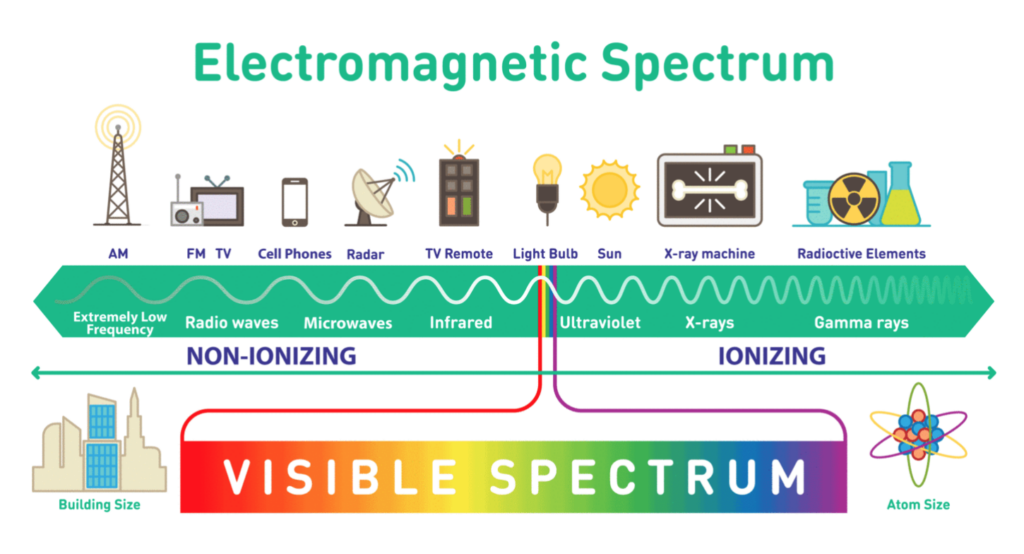(I would like to thank Defender Shield for the information in this article.)
Everywhere you look, there are computers, laptops, cell phones, tablets, WiFi networks, smart gadgets, and other electronic devices. And every year, the numbers of these devices continue to increase.
As of 2019,
- 95% of Americans own a smartphone
- 73% of Americans own a PC/Laptop
- 53% of Americans own a tablet computer
Unsurprisingly, electronic devices are not only growing in popularity, they are growing in usage — meaning more people are buying them, and are also using them for longer and longer periods.
According to a Nielsen survey, the average American spends 11+ hours a day with electronic media.
Time spent watching live TV has been decreasing, as time spent on TV-connected devices, as well as smartphone apps, has increased.
The average amount of sleep a person must have each night is 7.5-9 hours, meaning we spend approximately two-thirds of our waking hours wired.
Despite the amount of time we spend using them, the average person doesn’t know very much about how electronics actually work.
Every electronic device emits forms of Electromagnetic Field radiation, also called EMFs. They use an electric current passing through a circuit to perform a function. From your hair dryer to your smartphone, these levels vary based on the purpose of the device.
Electromagnetic fields are considered “radiation,” a byproduct of energy transmission.
As a result of electrons moving, electricity is generated in one direction and magnetism in another. This results in energy moving in two directions. The energy of the electricity moves on an x-axis and perpendicularly at a 90 degree angle a magnetic field is generated alongside it.
These energy fields travel predominantly in waves, and the different energy levels of waves are ordered together on the Electromagnetic Radiation Spectrum.

Generally speaking, there are two broad categories of electromagnetic frequencies on the spectrum: “Non-Ionizing Radiation” and “Ionizing Radiation.”
The radiation emitting by our electronic devices, like our cell phones, laptops, tablets, televisions, cell towers, and Bluetooth headphones, are all classified as low-energy non-ionizing radiation (commonly referred to simply as EMF), as opposed to the high-energy ionizing radiation.
Ionizing radiation is directly harmful to cells, and it can even ionize (split) atoms. An extreme example of ionizing radiation would be that of an atomic bomb.
Non-ionizing radiation is low energy and some argue that it is safe for that reason. However, health concerns such as cell damage, are not immediately seen with non-ionizing radiation exposure but are still very much a health danger.
Types of EMFs & How They are Created
Electronic devices emit 2 distinctly different types of radiation, ELF and RF emissions.
Extremely Low Frequency (ELF) EMFs
Electronic devices offer computing functions, phone calls, Internet connections, light up panels, and so many more capabilities.
As a by-product of these functions operating, an electric current is generated that flows within and between components creating EMFs. This type of radiation is also known as Extremely Low Frequency (ELF).
Radio Frequency (RF) EMFs
Electronic devices also communicate outside the device, transmitting communication signals from your device to other devices so you can talk to a friend on a phone or maybe connect to the Internet with your WiFi. These signals are called Radio Frequency (RF) signals and can also be referred to as Microwave (MW) signals.
RF signals can be transmitted at many different frequencies and power levels. A cell phone signal, for example can travel several miles, while a WiFi signal stays below 100 feet.
These varying distance capabilities require the electronics to generate differing power levels in order to accommodate the distances.
EMF’s Impact
A growing body of scientists believe that exposure to non-ionizing radiation over prolonged periods, such as years, may cause serious health issues, and current scientific studies are substantiating their concerns.
Similar to how the Grand Canyon was created, a small force over a long period of time can cause great changes. With people using these devices close to their bodies on a regular basis, many are becoming concerned about their constant exposure to EMFs, especially now that the length of exposure has spanned more than a decade.
Science tells us that low-energy EMF radiation can have an impact on the human body and our cells’ biology, regardless of EMF’s ability to heat cells (which can also be damaging). Additionally, our bodies use electricity within to properly function and external signals from electronic devices can interrupt or confuse living tissue.
An overwhelming number of studies have been conducted on EMF radiation that show there can be many risks to our health.
The World Health Organization established an International Electromagnetic Fields Project in 1996 to assess the scientific evidence for possible adverse health effects from EMFs and the work continues to this day.
Nonetheless, because many electronic devices we use everyday like laptops, tablets, and cell phones are relatively recent commodities, studies that can show actual long-term health implications have not been published yet. Scientific studies can take up to 20 years or more to establish definitive conclusions.
We urge that for now, the precautionary approach be taken, where we limit our exposure to electronic devices as much as we can until definitive evidence comes about.


